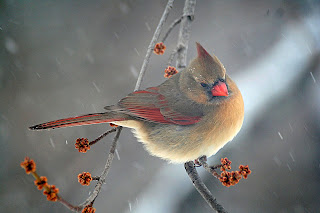
Notes from another interesting year of birds and birding
(published 12-7-10)
As I like to say every December, it was a good year to be a birder! Allow me to reflect a little bit on 2010 and share a few random thoughts and observations.
It seemed like a banner year for blue jays and cedar waxwings—two of the best-dressed birds in the neighborhood . . .
My favorite backyard regular, the red-breasted nuthatch, is at the bottom of the pecking order. When one is on the peanut feeder, and a red-bellied woodpecker swoops in, it’s like a Matchbox giving way to a Tonka. But the little guy always comes back . . .
Chickadees are always checking out my hummingbird feeder. Are they too attracted to the color red? I think they are just curious . . .
My all-time yard list grew by three this year: red-headed woodpecker, blue-winged warbler and golden-winged warbler. Yes, the birding gods were properly thanked . . .
While I’m skirting the “anything is possible” category, did you hear about the American anhinga that was sighted over DuPage County on November 18? Or what about that summer tanager that showed up in Gurnee on Veterans Day? Reports like these always make my day . . .
I’ve heard great-horned owls hooting in my neighborhood 11 times so far in 2010. I’m a birder. I take notes. I keep lists . . .
Twitter. It sounds so birdy and yet I just can’t make myself use it . . .
My favorite field trip in 2010 was to Horicon Marsh in Wisconsin. It’s our closest National Wildlife Refuge and the birding is superb. Be sure to take the pontoon boat tour . . .
Dang, I totally missed International Vulture Awareness Day on September 4th . . .
The Illinois Young Birders Club was founded in March. What a great idea and kudos to the Illinois Ornithological Society for getting it off the ground . . .
Five Christmas gift ideas: peanut feeder, heated bird bath, better binoculars, 365 Birds calendar and a copy of the awesome new Stokes field guide—the one with the painted bunting on the cover . . .
Speaking of Don and Lillian Stokes, mark your calendar: The DuPage Birding Club is bringing them here to speak and sign books on May 12. Watch the club’s website for time and location. Non-members are welcome . . .
Something I learned: Bald eagles and golden eagles are not closely related. Picked that up in an article by Kenn Kaufman . . .
The sandwich tern that visited the Chicago lakeshore in September was only the second one ever recorded in Illinois. It even made the news on WBBM Radio 780. Love it when birding gets a little mainstream attention like that . . .
Best license plate I saw in 2010: “Screech.” Below it, a bumper sticker: “So Many Species, So Little Time.” The driver, from Michigan, was a member of the Washtenaw Wingnuts. That’s either a birding club or a minor league baseball team . . .
I feel bad for Hedwig . . .
Sorry, but you need to adjust your Life List: the whip-poor-will is now officially the eastern whip-poor-will. The American Ornithological Union says so . . .
When did you see your first junco this fall? For me it was October 7 . . .
Amazing bargain sighting: 50 pounds of black-oil sunflower seed for $11.98, at Menards. Not an everyday price, but still . . .
Favorite headline in 2010, from Bird Watcher’s Digest: “In Praise of Sewage Lagoons: Smelly but Birdy!” . . .
I also enjoyed this line, from an online posting by the Evanston North Shore Bird Club: “Our leaders have found some great manure piles, so get ready to tour fields and dairy farms for horned larks, Lapland longspurs, snow buntings, and maybe even a rough-legged hawk!” . . .
This might be a good winter for the winter finches like pine siskins and common redpolls. Keep a close eye on your thistle feeder . . .
Place your bids for an original copy of John James Audubon’s “Birds of America.” The book will be auctioned this month by Sotheby’s and is expected to bring at least $6 million. Check your attic, too . . .
Three birds I’ve only seen once and can’t wait to see again: least bittern, cerulean warbler and northern shrike . . .
Pack the car: Eagle Watch Weekend at Starved Rock State Park is January 22-23 . . .
Julie Zickefoose simply has a great blog. I’m addicted. Give her a Google . . .
If I see only one movie in 2011, it will be “The Big Year,” with Steve Martin, Owen Wilson and Jack Black . . .
And if I read only one book, “The Biggest Twitch: Around the World in 4,000 Birds” . . .
“Bird Feathers,” another new book, is on my want-list too. It’s an ID guide . . .
My New Year’s resolutions: 1) become a regular eBird user 2) join American Bird Conservancy and 3) see a Kentucky warbler . . .
I want that Kentucky so bad that I’m offering a bounty. Show me the bird and I’ll write a $25 check to the nature charity of your choice . . .
Oh, and I never did see that black-throated gray warbler at Elsen’s Hill in West Chicago. Sort of pathetic considering it stayed for well over a month and I work only two miles away . . .
Come to think of it, I didn’t get a single “lifer” in 2010. Guess I need to get out more. Let’s all make that a goal for 2011, shall we? Best wishes for a happy new year of birding.
Copyright 2010 by Jeff Reiter. All rights reserved.
Northern shrike photo by Mike Daley








